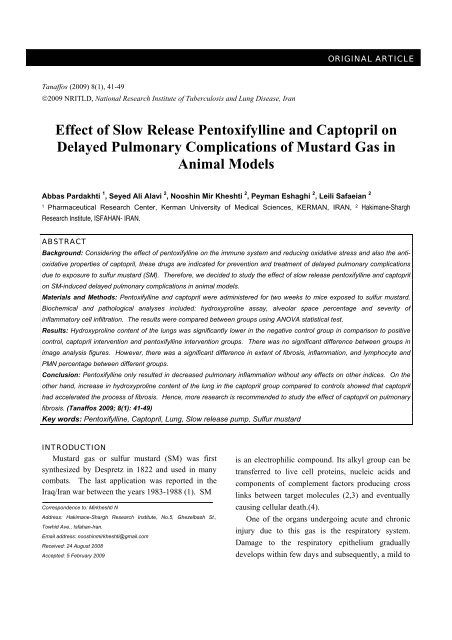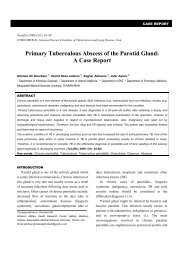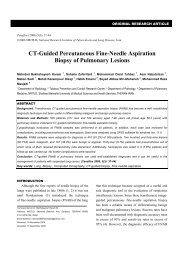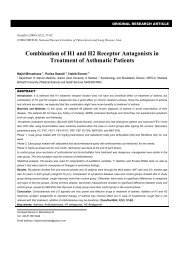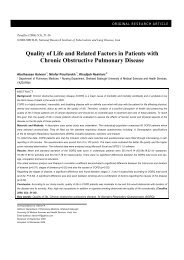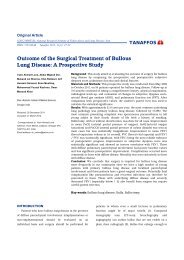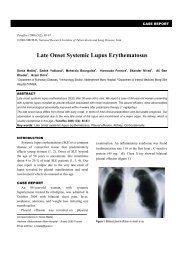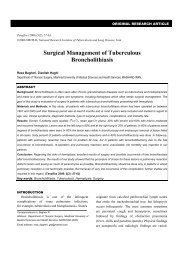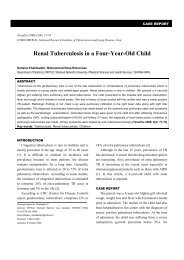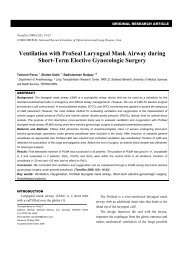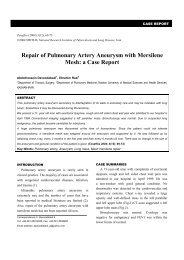Effect of Slow Release Pentoxifylline and Captopril on ... - Tanaffos
Effect of Slow Release Pentoxifylline and Captopril on ... - Tanaffos
Effect of Slow Release Pentoxifylline and Captopril on ... - Tanaffos
You also want an ePaper? Increase the reach of your titles
YUMPU automatically turns print PDFs into web optimized ePapers that Google loves.
ORIGINAL ARTICLE<strong>Tanaffos</strong> (2009) 8(1), 41-49©2009 NRITLD, Nati<strong>on</strong>al Research Institute <str<strong>on</strong>g>of</str<strong>on</strong>g> Tuberculosis <str<strong>on</strong>g>and</str<strong>on</strong>g> Lung Disease, Iran<str<strong>on</strong>g>Effect</str<strong>on</strong>g> <str<strong>on</strong>g>of</str<strong>on</strong>g> <str<strong>on</strong>g>Slow</str<strong>on</strong>g> <str<strong>on</strong>g>Release</str<strong>on</strong>g> <str<strong>on</strong>g>Pentoxifylline</str<strong>on</strong>g> <str<strong>on</strong>g>and</str<strong>on</strong>g> <str<strong>on</strong>g>Captopril</str<strong>on</strong>g> <strong>on</strong>Delayed Pulm<strong>on</strong>ary Complicati<strong>on</strong>s <str<strong>on</strong>g>of</str<strong>on</strong>g> Mustard Gas inAnimal ModelsAbbas Pardakhti 1 , Seyed Ali Alavi 2 , Nooshin Mir Kheshti 2 , Peyman Eshaghi 2 , Leili Safaeian 21 Pharmaceutical Research Center, Kerman University <str<strong>on</strong>g>of</str<strong>on</strong>g> Medical Sciences, KERMAN, IRAN, 2 Hakimane-SharghResearch Institute, ISFAHAN- IRAN.ABSTRACTBackground: C<strong>on</strong>sidering the effect <str<strong>on</strong>g>of</str<strong>on</strong>g> pentoxifylline <strong>on</strong> the immune system <str<strong>on</strong>g>and</str<strong>on</strong>g> reducing oxidative stress <str<strong>on</strong>g>and</str<strong>on</strong>g> also the antioxidativeproperties <str<strong>on</strong>g>of</str<strong>on</strong>g> captopril, these drugs are indicated for preventi<strong>on</strong> <str<strong>on</strong>g>and</str<strong>on</strong>g> treatment <str<strong>on</strong>g>of</str<strong>on</strong>g> delayed pulm<strong>on</strong>ary complicati<strong>on</strong>sdue to exposure to sulfur mustard (SM). Therefore, we decided to study the effect <str<strong>on</strong>g>of</str<strong>on</strong>g> slow release pentoxifylline <str<strong>on</strong>g>and</str<strong>on</strong>g> captopril<strong>on</strong> SM-induced delayed pulm<strong>on</strong>ary complicati<strong>on</strong>s in animal models.Materials <str<strong>on</strong>g>and</str<strong>on</strong>g> Methods: <str<strong>on</strong>g>Pentoxifylline</str<strong>on</strong>g> <str<strong>on</strong>g>and</str<strong>on</strong>g> captopril were administered for two weeks to mice exposed to sulfur mustard.Biochemical <str<strong>on</strong>g>and</str<strong>on</strong>g> pathological analyses included: hydroxyproline assay, alveolar space percentage <str<strong>on</strong>g>and</str<strong>on</strong>g> severity <str<strong>on</strong>g>of</str<strong>on</strong>g>inflammatory cell infiltrati<strong>on</strong>. The results were compared between groups using ANOVA statistical test.Results: Hydroxyproline c<strong>on</strong>tent <str<strong>on</strong>g>of</str<strong>on</strong>g> the lungs was significantly lower in the negative c<strong>on</strong>trol group in comparis<strong>on</strong> to positivec<strong>on</strong>trol, captopril interventi<strong>on</strong> <str<strong>on</strong>g>and</str<strong>on</strong>g> pentoxifylline interventi<strong>on</strong> groups. There was no significant difference between groups inimage analysis figures. However, there was a significant difference in extent <str<strong>on</strong>g>of</str<strong>on</strong>g> fibrosis, inflammati<strong>on</strong>, <str<strong>on</strong>g>and</str<strong>on</strong>g> lymphocyte <str<strong>on</strong>g>and</str<strong>on</strong>g>PMN percentage between different groups.C<strong>on</strong>clusi<strong>on</strong>: <str<strong>on</strong>g>Pentoxifylline</str<strong>on</strong>g> <strong>on</strong>ly resulted in decreased pulm<strong>on</strong>ary inflammati<strong>on</strong> without any effects <strong>on</strong> other indices. On theother h<str<strong>on</strong>g>and</str<strong>on</strong>g>, increase in hydroxyproline c<strong>on</strong>tent <str<strong>on</strong>g>of</str<strong>on</strong>g> the lung in the captopril group compared to c<strong>on</strong>trols showed that captoprilhad accelerated the process <str<strong>on</strong>g>of</str<strong>on</strong>g> fibrosis. Hence, more research is recommended to study the effect <str<strong>on</strong>g>of</str<strong>on</strong>g> captopril <strong>on</strong> pulm<strong>on</strong>aryfibrosis. (<strong>Tanaffos</strong> 2009; 8(1): 41-49)Key words: <str<strong>on</strong>g>Pentoxifylline</str<strong>on</strong>g>, <str<strong>on</strong>g>Captopril</str<strong>on</strong>g>, Lung, <str<strong>on</strong>g>Slow</str<strong>on</strong>g> release pump, Sulfur mustardINTRODUCTIONMustard gas or sulfur mustard (SM) was firstsynthesized by Despretz in 1822 <str<strong>on</strong>g>and</str<strong>on</strong>g> used in manycombats. The last applicati<strong>on</strong> was reported in theIraq/Iran war between the years 1983-1988 (1). SMCorresp<strong>on</strong>dence to: Mirkheshti NAddress: Hakimane-Shargh Research Institute, No.5, Ghezelbash St.,Towhid Ave., Isfahan-Iran.Email address: nooshinmirkheshti@gmail.comReceived: 24 August 2008Accepted: 5 February 2009is an electrophilic compound. Its alkyl group can betransferred to live cell proteins, nucleic acids <str<strong>on</strong>g>and</str<strong>on</strong>g>comp<strong>on</strong>ents <str<strong>on</strong>g>of</str<strong>on</strong>g> complement factors producing crosslinks between target molecules (2,3) <str<strong>on</strong>g>and</str<strong>on</strong>g> eventuallycausing cellular death.(4).One <str<strong>on</strong>g>of</str<strong>on</strong>g> the organs undergoing acute <str<strong>on</strong>g>and</str<strong>on</strong>g> chr<strong>on</strong>icinjury due to this gas is the respiratory system.Damage to the respiratory epithelium graduallydevelops within few days <str<strong>on</strong>g>and</str<strong>on</strong>g> subsequently, a mild to
42 <str<strong>on</strong>g>Slow</str<strong>on</strong>g> <str<strong>on</strong>g>Release</str<strong>on</strong>g> <str<strong>on</strong>g>Pentoxifylline</str<strong>on</strong>g> <str<strong>on</strong>g>and</str<strong>on</strong>g> <str<strong>on</strong>g>Captopril</str<strong>on</strong>g>severe inflammatory reacti<strong>on</strong> occurs which isaccompanied by epithelial necrosis <str<strong>on</strong>g>and</str<strong>on</strong>g> eventually,acute inflammati<strong>on</strong> <str<strong>on</strong>g>of</str<strong>on</strong>g> the upper <str<strong>on</strong>g>and</str<strong>on</strong>g> lowerrespiratory tracts (5). Even following resoluti<strong>on</strong> <str<strong>on</strong>g>of</str<strong>on</strong>g>acute complicati<strong>on</strong>s, a persistent respiratory distresscan occur in the exposed victims. In follow up <str<strong>on</strong>g>of</str<strong>on</strong>g>200 Iranian patients with severe exposure to SM,near <strong>on</strong>e-third <str<strong>on</strong>g>of</str<strong>on</strong>g> the individuals showed chr<strong>on</strong>icrespiratory symptoms two years later. Reportedcomplicati<strong>on</strong>s included: br<strong>on</strong>chitis, asthma,laryngitis, tracheobr<strong>on</strong>chitis, recurrent pneum<strong>on</strong>ia,<str<strong>on</strong>g>and</str<strong>on</strong>g> br<strong>on</strong>chiectasis (6-8).In acute SM exposure, oxidative stress isresp<strong>on</strong>sible for at least partial toxicity to internalorgans <str<strong>on</strong>g>and</str<strong>on</strong>g> local tissues. In cell cultureenvir<strong>on</strong>ments, c<strong>on</strong>tact <str<strong>on</strong>g>of</str<strong>on</strong>g> this agent with live cellsleads to loss <str<strong>on</strong>g>of</str<strong>on</strong>g> anti-oxidant protecti<strong>on</strong> by thecells.(9) On the other h<str<strong>on</strong>g>and</str<strong>on</strong>g>, role <str<strong>on</strong>g>of</str<strong>on</strong>g> oxidative stress inthe pathogenesis <str<strong>on</strong>g>of</str<strong>on</strong>g> tissue inflammati<strong>on</strong> has alreadybeen established (10) <str<strong>on</strong>g>and</str<strong>on</strong>g> there is a possibility thatoxidative stress, active oxygen radicals <str<strong>on</strong>g>and</str<strong>on</strong>g> lack <str<strong>on</strong>g>of</str<strong>on</strong>g>anti-oxidant protecti<strong>on</strong> are involved in delayedcomplicati<strong>on</strong>s due to SM c<strong>on</strong>sidering the chr<strong>on</strong>icinflammati<strong>on</strong> <str<strong>on</strong>g>of</str<strong>on</strong>g> the lower respiratory tract <str<strong>on</strong>g>and</str<strong>on</strong>g> itsprogressive nature (11, 12). As a result, medicati<strong>on</strong>swhich can decrease oxidative stress may prevent ordecrease damage or treat late side effects in thoseexposed to SM.<str<strong>on</strong>g>Pentoxifylline</str<strong>on</strong>g> is a methylxanthine derivative thatparticipates in immune modulati<strong>on</strong> by preventinglymphocyte (13) <str<strong>on</strong>g>and</str<strong>on</strong>g> neutrophil cytotoxicity (14, 15).This drug decreases inflammatory cytokine releasesuch as TNF-alpha (16, 17); <strong>on</strong> the other h<str<strong>on</strong>g>and</str<strong>on</strong>g>, itdecreases oxidative stress (18) <str<strong>on</strong>g>and</str<strong>on</strong>g> lipid peroxidati<strong>on</strong>(19). As a result, it is believed to decrease SMtoxicity at the time <str<strong>on</strong>g>of</str<strong>on</strong>g> exposure <str<strong>on</strong>g>and</str<strong>on</strong>g> also due tochr<strong>on</strong>ic destructive mechanism <str<strong>on</strong>g>of</str<strong>on</strong>g> this agent, it mayinfluence the outcome <str<strong>on</strong>g>of</str<strong>on</strong>g> chr<strong>on</strong>ic SM-induced lunginjury.Another important c<strong>on</strong>siderati<strong>on</strong> is the influence<str<strong>on</strong>g>of</str<strong>on</strong>g> hypoxia <strong>on</strong> the formati<strong>on</strong> <str<strong>on</strong>g>of</str<strong>on</strong>g> pulm<strong>on</strong>ary fibrosis(20-22) <str<strong>on</strong>g>and</str<strong>on</strong>g> the effect <str<strong>on</strong>g>of</str<strong>on</strong>g> fibrosis <strong>on</strong> inducing hypoxia(23) which leads to a destructive cycle <str<strong>on</strong>g>and</str<strong>on</strong>g>progressi<strong>on</strong> <str<strong>on</strong>g>of</str<strong>on</strong>g> the c<strong>on</strong>diti<strong>on</strong>. Also, pentoxifylline c<str<strong>on</strong>g>and</str<strong>on</strong>g>ecrease hypoxia <str<strong>on</strong>g>and</str<strong>on</strong>g> prevent progressi<strong>on</strong> <str<strong>on</strong>g>of</str<strong>on</strong>g> diseasethrough its vasodilatory effect <str<strong>on</strong>g>and</str<strong>on</strong>g> decreasing bloodviscosity (24).<str<strong>on</strong>g>Captopril</str<strong>on</strong>g> decreases lipid peroxidati<strong>on</strong>, potentiatesthe intrinsic anti-oxidant system (25) <str<strong>on</strong>g>and</str<strong>on</strong>g> preventsalveolar epithelial cell apoptosis (26). Therefore, itcan have therapeutic effects.Additi<strong>on</strong>ally, several studies <strong>on</strong> lung fibrosissec<strong>on</strong>dary to paraquat, amiodar<strong>on</strong>e <str<strong>on</strong>g>and</str<strong>on</strong>g> radiati<strong>on</strong>have shown beneficial effects <str<strong>on</strong>g>of</str<strong>on</strong>g> this drug (25-27).The important point about these two medicati<strong>on</strong>sis their short half life. The half life <str<strong>on</strong>g>of</str<strong>on</strong>g> captopril isless than 3 hours <str<strong>on</strong>g>and</str<strong>on</strong>g> if the original form <str<strong>on</strong>g>of</str<strong>on</strong>g> themedicati<strong>on</strong> is used, its half life would be less than 2hours (28). The half life <str<strong>on</strong>g>of</str<strong>on</strong>g> pentoxifylline is 0.4 to0.8 hour. This time is 1-1.6 hours for its metabolites(24). Therefore, a protocol that can maintain aneffective c<strong>on</strong>stant c<strong>on</strong>centrati<strong>on</strong> <str<strong>on</strong>g>of</str<strong>on</strong>g> these drugs intissues without their c<strong>on</strong>tinuous administrati<strong>on</strong> canincrease their effectiveness.C<strong>on</strong>sidering the current opini<strong>on</strong>s about theeffectiveness <str<strong>on</strong>g>of</str<strong>on</strong>g> these two medicati<strong>on</strong>s in preventi<strong>on</strong><str<strong>on</strong>g>and</str<strong>on</strong>g> treatment <str<strong>on</strong>g>of</str<strong>on</strong>g> SM-related late pulm<strong>on</strong>arycomplicati<strong>on</strong>s, this study was planned to evaluate theeffectiveness <str<strong>on</strong>g>of</str<strong>on</strong>g> slow release forms <str<strong>on</strong>g>of</str<strong>on</strong>g> thesemedicati<strong>on</strong>s in animal models.MATERIALS AND METHODSDuring an experimental study, 30 female micewith the mean weight <str<strong>on</strong>g>of</str<strong>on</strong>g> 23±2g were selected. Themice did not have clinical signs <str<strong>on</strong>g>of</str<strong>on</strong>g> respiratory orgastrointestinal infecti<strong>on</strong>. They were provided by thePasteur Institute <str<strong>on</strong>g>of</str<strong>on</strong>g> Iran <str<strong>on</strong>g>and</str<strong>on</strong>g> were kept in similarst<str<strong>on</strong>g>and</str<strong>on</strong>g>ard nutriti<strong>on</strong>al <str<strong>on</strong>g>and</str<strong>on</strong>g> envir<strong>on</strong>mental c<strong>on</strong>diti<strong>on</strong>s<str<strong>on</strong>g>and</str<strong>on</strong>g> a 12-hour light/12 hour dark cycle. The micewere kept for two weeks <str<strong>on</strong>g>and</str<strong>on</strong>g> when we got reassured<strong>Tanaffos</strong> 2009; 8(1): 41-49
Pardakhti A, et al. 43about their health, we r<str<strong>on</strong>g>and</str<strong>on</strong>g>omly divided them into 5groups each c<strong>on</strong>taining 6 mice.Group 1: Negative c<strong>on</strong>trol (in this group nointerventi<strong>on</strong> was d<strong>on</strong>e <str<strong>on</strong>g>and</str<strong>on</strong>g> it was selected forpossible envir<strong>on</strong>mental c<strong>on</strong>founders influencing theexperimental results)Group 2: An interventi<strong>on</strong> group receivingpentoxifyllineGroup 3: An interventi<strong>on</strong> group receivingcaptoprilGroup 4: Positive c<strong>on</strong>trol for captopril (includedmice exposed to sulfur mustard <str<strong>on</strong>g>and</str<strong>on</strong>g> no medicalinterventi<strong>on</strong>)Group 5: Positive c<strong>on</strong>trol for pentoxifylline(included mice exposed to sulfur mustard <str<strong>on</strong>g>and</str<strong>on</strong>g> nomedical interventi<strong>on</strong>)(Groups 2 <str<strong>on</strong>g>and</str<strong>on</strong>g> 3 included mice exposed to sulfurmustard that underwent medical interventi<strong>on</strong>.)Initially, ALZET pumps (DURECTcorporati<strong>on</strong>/CA) were loaded with the medicati<strong>on</strong>under sterile c<strong>on</strong>diti<strong>on</strong>s. These pumps have a dailyrelease <str<strong>on</strong>g>of</str<strong>on</strong>g> medicati<strong>on</strong> equal to 6 microliters.Therefore, to prepare ALZET pumps for group 2(pentoxifylline), 200 mg pentoxifylline (1/2 Tab) wasdissolved in 2.85 ml <str<strong>on</strong>g>of</str<strong>on</strong>g> distilled water <str<strong>on</strong>g>and</str<strong>on</strong>g> 200microliters <str<strong>on</strong>g>of</str<strong>on</strong>g> this soluti<strong>on</strong> was administered into thepumps. To prepare these pumps in group 3(captopril), 250mg captopril (5 tablets, each 50 mg)was dissolved in 1.2 ml distilled water <str<strong>on</strong>g>and</str<strong>on</strong>g> 200microliter <str<strong>on</strong>g>of</str<strong>on</strong>g> this soluti<strong>on</strong> was administered into thepumps. In group 2, pentoxifylline 20mg/kg/day wasadministered via the ALZET pump starting 48 hoursbefore the administrati<strong>on</strong> <str<strong>on</strong>g>of</str<strong>on</strong>g> sulfur mustard <str<strong>on</strong>g>and</str<strong>on</strong>g> wasc<strong>on</strong>tinued for 20 days. Group 3 also receivedcaptopril via the described method at a dose <str<strong>on</strong>g>of</str<strong>on</strong>g> 50mg/Kg/day via ALZET pump starting 48 hoursbefore the administrati<strong>on</strong> <str<strong>on</strong>g>of</str<strong>on</strong>g> mustard gas <str<strong>on</strong>g>and</str<strong>on</strong>g>c<strong>on</strong>tinued for 14 days. The pumps were implantedinto the mice as follows:Initially, the mice were anesthetized withintraperit<strong>on</strong>eal injecti<strong>on</strong> <str<strong>on</strong>g>of</str<strong>on</strong>g> ketamine <str<strong>on</strong>g>and</str<strong>on</strong>g> xylocaine(with a 2 to 1 ratio). Then, the hair behind their neckwas shaved <str<strong>on</strong>g>and</str<strong>on</strong>g> the skin was disinfected withantiseptics. Under sterile c<strong>on</strong>diti<strong>on</strong>s, a 1.5 cmsagittal incisi<strong>on</strong> was made at the menti<strong>on</strong>ed site <str<strong>on</strong>g>and</str<strong>on</strong>g> aspace was created under the mouse’s skin whereALZET pumps were placed. The incisi<strong>on</strong> site wassutured with chromic 2/0 surgical suture. Groups 4<str<strong>on</strong>g>and</str<strong>on</strong>g> 5 (positive c<strong>on</strong>trols) also had plastic pumps inthe dimensi<strong>on</strong>s <str<strong>on</strong>g>of</str<strong>on</strong>g> the ALZET pumps insertedsubcutaneously as placebo. Forty-eight hours afterimplantati<strong>on</strong> <str<strong>on</strong>g>of</str<strong>on</strong>g> the pumps, 24 <str<strong>on</strong>g>of</str<strong>on</strong>g> the 23±2 gramfemale mice (Groups 2,3,4, <str<strong>on</strong>g>and</str<strong>on</strong>g> 5) were placed in aclosed c<strong>on</strong>tainer <str<strong>on</strong>g>of</str<strong>on</strong>g> sulfur mustard gas withc<strong>on</strong>centrati<strong>on</strong> <str<strong>on</strong>g>of</str<strong>on</strong>g> 600 mg/m 3 . At the same time, 6healthy mice without gas exposure (group 1) wereselected as the negative c<strong>on</strong>trols for the study.After completi<strong>on</strong> <str<strong>on</strong>g>of</str<strong>on</strong>g> the experiment, the micewere euthanized <str<strong>on</strong>g>and</str<strong>on</strong>g> their lungs were removed. Theright lungs were placed in 10% formalin formicroscopic slide preparati<strong>on</strong> <str<strong>on</strong>g>and</str<strong>on</strong>g> pathologicevaluati<strong>on</strong>. The left lungs were placed in specialc<strong>on</strong>tainers <str<strong>on</strong>g>and</str<strong>on</strong>g> dried in incubator for hydroxyprolineassay.For the hydroxyproline assay, the left lungs wereweighed after being dried in the oven for 12 hours at90°C, <str<strong>on</strong>g>and</str<strong>on</strong>g> then the Woessner method was applied toassess their total hydroxyproline c<strong>on</strong>tent (see below)(36). Additi<strong>on</strong>ally, by using MATLAB s<str<strong>on</strong>g>of</str<strong>on</strong>g>tware thepercentage <str<strong>on</strong>g>of</str<strong>on</strong>g> alveolar space was estimated <str<strong>on</strong>g>and</str<strong>on</strong>g>compared am<strong>on</strong>g the groups.Pathologic Evaluati<strong>on</strong>:After tissue preparati<strong>on</strong>, the right lungs <str<strong>on</strong>g>of</str<strong>on</strong>g> themice were cut for slides <str<strong>on</strong>g>and</str<strong>on</strong>g> stained with H&E todetermine the severity <str<strong>on</strong>g>of</str<strong>on</strong>g> fibrosis <str<strong>on</strong>g>and</str<strong>on</strong>g> inflammati<strong>on</strong>by a pathologist. Indices for fibrosis <str<strong>on</strong>g>and</str<strong>on</strong>g>inflammati<strong>on</strong> were graded from 1 to 4 using 400xmagnificati<strong>on</strong>. Percentage <str<strong>on</strong>g>of</str<strong>on</strong>g> m<strong>on</strong><strong>on</strong>uclear <str<strong>on</strong>g>and</str<strong>on</strong>g>multinuclear cells in the samples was alsodetermined. All slides were evaluated at the same<strong>Tanaffos</strong> 2009; 8(1): 41-49
44 <str<strong>on</strong>g>Slow</str<strong>on</strong>g> <str<strong>on</strong>g>Release</str<strong>on</strong>g> <str<strong>on</strong>g>Pentoxifylline</str<strong>on</strong>g> <str<strong>on</strong>g>and</str<strong>on</strong>g> <str<strong>on</strong>g>Captopril</str<strong>on</strong>g>time <str<strong>on</strong>g>and</str<strong>on</strong>g> the pathologist was unaware <str<strong>on</strong>g>of</str<strong>on</strong>g> theirclassificati<strong>on</strong>.Hydroxyproline Assay:To measure the quantity <str<strong>on</strong>g>of</str<strong>on</strong>g> hydroxyproline by theWoessner method (29), the lungs were weighed afterdrying in an oven for 12 hours at 90°C. Then, thetissue sample was hydrolyzed in 6 molarhydrochloride acid at 110°C for 12 hours.Subsequently, 50 microliter citrate acetate buffer(c<strong>on</strong>taining 5% citric acid, 1.2% glacial acetic acid,7.24% sodium acetate, <str<strong>on</strong>g>and</str<strong>on</strong>g> 3.4% sodium hydroxide)<str<strong>on</strong>g>and</str<strong>on</strong>g> <strong>on</strong>e ml <str<strong>on</strong>g>of</str<strong>on</strong>g> chloramine T soluti<strong>on</strong> (0.564chloramine T, 4 ml propanol, 32 ml citrate acetatebuffer) were added to the samples <str<strong>on</strong>g>and</str<strong>on</strong>g> then thesamples were placed at room temperature for 20minutes. Afterwards, <strong>on</strong>e ml <str<strong>on</strong>g>of</str<strong>on</strong>g> Ehrlich soluti<strong>on</strong> (4.5mg dimethyl-amino-benzaldehyde in 18.6 mlpropanol <str<strong>on</strong>g>and</str<strong>on</strong>g> 7.8 ml perchloric acid) was added <str<strong>on</strong>g>and</str<strong>on</strong>g>incubated at 65°C for 15 minutes. Finally, lightabsorpti<strong>on</strong> <str<strong>on</strong>g>of</str<strong>on</strong>g> samples was measured at 550nm usinga spectrophotometer <str<strong>on</strong>g>and</str<strong>on</strong>g> was compared to purehydroxyproline st<str<strong>on</strong>g>and</str<strong>on</strong>g>ardized measuring curve. Allmeasurements were performed at the same time <str<strong>on</strong>g>and</str<strong>on</strong>g>the biochemistry technician was unaware <str<strong>on</strong>g>of</str<strong>on</strong>g> thegrouping <str<strong>on</strong>g>of</str<strong>on</strong>g> the samples.Computerized Estimati<strong>on</strong> <str<strong>on</strong>g>of</str<strong>on</strong>g> the Index <str<strong>on</strong>g>of</str<strong>on</strong>g> Fibrosis:A method for assessing the severity <str<strong>on</strong>g>of</str<strong>on</strong>g> fibrosis<str<strong>on</strong>g>and</str<strong>on</strong>g> br<strong>on</strong>chitis is estimati<strong>on</strong> <str<strong>on</strong>g>of</str<strong>on</strong>g> the total lung capacity(TLC). To measure this index in pathologic slides,the ratio <str<strong>on</strong>g>of</str<strong>on</strong>g> alveolar space to parenchyma in amicroscopic field was assessed. By using theMATLAB 6 program, 5 slide fields with 100xmagnificati<strong>on</strong> were selected <str<strong>on</strong>g>and</str<strong>on</strong>g> percentage <str<strong>on</strong>g>of</str<strong>on</strong>g>alveolar space was measured as an index <str<strong>on</strong>g>of</str<strong>on</strong>g> TLC <str<strong>on</strong>g>and</str<strong>on</strong>g>a mean was calculated for each slide. Since thealveolar space is white <strong>on</strong> microscopic examinati<strong>on</strong>,special s<str<strong>on</strong>g>of</str<strong>on</strong>g>tware was used to estimate the percentage<str<strong>on</strong>g>of</str<strong>on</strong>g> white color compared to other colors (lungparenchyma) <str<strong>on</strong>g>and</str<strong>on</strong>g> this characteristic was used as anindex for fibrosis (30).Analysis <str<strong>on</strong>g>of</str<strong>on</strong>g> Results:The results were analyzed using SPSS s<str<strong>on</strong>g>of</str<strong>on</strong>g>twareversi<strong>on</strong> 13 <str<strong>on</strong>g>and</str<strong>on</strong>g> expressed as mean ± SD. Initially,normal distributi<strong>on</strong> <str<strong>on</strong>g>of</str<strong>on</strong>g> the variable was evaluatedusing the Kolmogorov-Smirnov statistical test.Quantitative measures were analyzed using ANOVA<str<strong>on</strong>g>and</str<strong>on</strong>g> Tukey Post Hoc analyses <str<strong>on</strong>g>and</str<strong>on</strong>g> qualitativevariables using the Chi-square test. P-value less than0.05 was c<strong>on</strong>sidered significant. Additi<strong>on</strong>ally, for amore comprehensive comparis<strong>on</strong> between thegroups, the mean values for the two positive c<strong>on</strong>trolgroups were determined <str<strong>on</strong>g>and</str<strong>on</strong>g> presented as <strong>on</strong>e singlegroup.RESULTSIn the present study, all mice survived <str<strong>on</strong>g>and</str<strong>on</strong>g> had noinfecti<strong>on</strong> or other complicati<strong>on</strong>s during the study <str<strong>on</strong>g>and</str<strong>on</strong>g>follow-up period. Numerical results frompathological <str<strong>on</strong>g>and</str<strong>on</strong>g> biochemical analyses are presentedin Table 1.Table 1. Mean <str<strong>on</strong>g>and</str<strong>on</strong>g> st<str<strong>on</strong>g>and</str<strong>on</strong>g>ard deviati<strong>on</strong> <str<strong>on</strong>g>of</str<strong>on</strong>g> indices am<strong>on</strong>g the study groupsGroupsIndicesNegative C<strong>on</strong>trol Positive C<strong>on</strong>trol <str<strong>on</strong>g>Captopril</str<strong>on</strong>g> <str<strong>on</strong>g>Pentoxifylline</str<strong>on</strong>g> P-valuePercentage <str<strong>on</strong>g>of</str<strong>on</strong>g> lymphocytes 97.2±3.01 78.5±12 85±10 91.42±3.77 P
Pardakhti A, et al. 45Based <strong>on</strong> the results <str<strong>on</strong>g>of</str<strong>on</strong>g> hydroxyprolinemeasurements, a significant difference was observedin the hydroxyproline c<strong>on</strong>tent <str<strong>on</strong>g>of</str<strong>on</strong>g> the lung am<strong>on</strong>gdifferent groups <str<strong>on</strong>g>and</str<strong>on</strong>g> the lung hydroxyproline level inthe negative c<strong>on</strong>trol group was significantly lowerthan that in the positive c<strong>on</strong>trol groups (p
46 <str<strong>on</strong>g>Slow</str<strong>on</strong>g> <str<strong>on</strong>g>Release</str<strong>on</strong>g> <str<strong>on</strong>g>Pentoxifylline</str<strong>on</strong>g> <str<strong>on</strong>g>and</str<strong>on</strong>g> <str<strong>on</strong>g>Captopril</str<strong>on</strong>g>have complicati<strong>on</strong>s <str<strong>on</strong>g>of</str<strong>on</strong>g> toxicity with this pois<strong>on</strong>. In astudy by Khateri <str<strong>on</strong>g>and</str<strong>on</strong>g> colleagues <strong>on</strong> 34,000 Iranianchemical warfare patients 13 to 20 years postexposure, the most comm<strong>on</strong> delayed complicati<strong>on</strong>sinvolved lungs (42.5%) followed by the eyes (39%)<str<strong>on</strong>g>and</str<strong>on</strong>g> skin (24.5%) (31).Pulm<strong>on</strong>ary disease is the most important cause <str<strong>on</strong>g>of</str<strong>on</strong>g>l<strong>on</strong>g-term disability am<strong>on</strong>g mustard gas victims (1).Based <strong>on</strong> a study <strong>on</strong> 197 Iranian soldiers 10 yearsafter extensive exposure to mustard gas, pulm<strong>on</strong>arycomplicati<strong>on</strong>s such as chr<strong>on</strong>ic br<strong>on</strong>chitis (58%),pulm<strong>on</strong>ary fibrosis (12%), asthma (10%), narrowing<str<strong>on</strong>g>of</str<strong>on</strong>g> large airways (9%) <str<strong>on</strong>g>and</str<strong>on</strong>g> br<strong>on</strong>chiectasis (8%) wereobserved (33).The pathogenesis <str<strong>on</strong>g>of</str<strong>on</strong>g> SM toxicity includesinflammatory cells infiltrati<strong>on</strong> (34), aggregati<strong>on</strong> <str<strong>on</strong>g>of</str<strong>on</strong>g>inflammatory mediators such as TNF-alpha (35),acute inflammati<strong>on</strong> followed by chr<strong>on</strong>icinflammati<strong>on</strong> <str<strong>on</strong>g>and</str<strong>on</strong>g> alveolar epithelial cell apoptosis(1) <str<strong>on</strong>g>and</str<strong>on</strong>g> eventually, activati<strong>on</strong> <str<strong>on</strong>g>of</str<strong>on</strong>g> fibroblasts <str<strong>on</strong>g>and</str<strong>on</strong>g>resultant pulm<strong>on</strong>ary fibrosis (11).According to a study performed by Emad <str<strong>on</strong>g>and</str<strong>on</strong>g>Rezaian, neutrophilic accumulati<strong>on</strong> in alveolarinflammati<strong>on</strong> (neutrophilic alveolitis) due to release<str<strong>on</strong>g>of</str<strong>on</strong>g> free radicals <str<strong>on</strong>g>and</str<strong>on</strong>g> proteases from the neutrophils isthe probable cause <str<strong>on</strong>g>of</str<strong>on</strong>g> initiati<strong>on</strong> <str<strong>on</strong>g>of</str<strong>on</strong>g> fibrosis (33).C<strong>on</strong>sidering the role <str<strong>on</strong>g>of</str<strong>on</strong>g> hypoxia, oxidative stress<str<strong>on</strong>g>and</str<strong>on</strong>g> inflammati<strong>on</strong> in the process <str<strong>on</strong>g>of</str<strong>on</strong>g> fibrosis, it issuggested that captopril <str<strong>on</strong>g>and</str<strong>on</strong>g> pentoxifylline mayinfluence at least <strong>on</strong>e <str<strong>on</strong>g>of</str<strong>on</strong>g> these mechanisms, leadingto treatment or preventing progressi<strong>on</strong> <str<strong>on</strong>g>of</str<strong>on</strong>g> fibrosis. Inthis study, lung fibrosis was induced in animalmodels using mustard gas <str<strong>on</strong>g>and</str<strong>on</strong>g> the effect <str<strong>on</strong>g>of</str<strong>on</strong>g> slowrelease captopril <str<strong>on</strong>g>and</str<strong>on</strong>g> pentoxifylline (which areusually used for treatment <str<strong>on</strong>g>of</str<strong>on</strong>g> other forms <str<strong>on</strong>g>of</str<strong>on</strong>g> fibrosis)was evaluated.The <str<strong>on</strong>g>Effect</str<strong>on</strong>g> <str<strong>on</strong>g>of</str<strong>on</strong>g> <str<strong>on</strong>g>Pentoxifylline</str<strong>on</strong>g> <strong>on</strong> Pulm<strong>on</strong>aryFibrosis:In previous studies, role <str<strong>on</strong>g>of</str<strong>on</strong>g> hypoxia in inducingpulm<strong>on</strong>ary fibrosis has been supported (20-22).Additi<strong>on</strong>ally, tissue inflammati<strong>on</strong> in acute or chr<strong>on</strong>icphases has been proposed as a mechanism <str<strong>on</strong>g>of</str<strong>on</strong>g> fibrosisformati<strong>on</strong> (33). C<strong>on</strong>sequently, it seems thatpentoxifylline as a vasodilating agent with significantanti-inflammatory properties (13-17) might treat orprevent progressi<strong>on</strong> <str<strong>on</strong>g>of</str<strong>on</strong>g> fibrotic lung disease.In some studies use <str<strong>on</strong>g>of</str<strong>on</strong>g> this medicati<strong>on</strong> hasdecreased tissue fibrosis (36,37).However, in this study despite the probable antiinflammatoryeffect <str<strong>on</strong>g>of</str<strong>on</strong>g> pentoxifylline <strong>on</strong> the micelungs, it could not treat pulm<strong>on</strong>ary fibrosis. Theresults <str<strong>on</strong>g>of</str<strong>on</strong>g> this study are similar to those <str<strong>on</strong>g>of</str<strong>on</strong>g> Keremer<str<strong>on</strong>g>and</str<strong>on</strong>g> colleagues in which pentoxifyline did notimprove lung fibrosis induced by bleomycin (38).The reas<strong>on</strong> may be the insufficient vasodilatoryeffect <str<strong>on</strong>g>of</str<strong>on</strong>g> pentoxifylline <strong>on</strong> the pulm<strong>on</strong>ary vessels.Therefore hypoxia cannot be revered effectively toprevent the process <str<strong>on</strong>g>of</str<strong>on</strong>g> fibrosis. But, c<strong>on</strong>sidering theanti-inflammatory effect <str<strong>on</strong>g>of</str<strong>on</strong>g> this drug <strong>on</strong> the lungs <str<strong>on</strong>g>and</str<strong>on</strong>g>the accepted role <str<strong>on</strong>g>of</str<strong>on</strong>g> inflammati<strong>on</strong> in the process <str<strong>on</strong>g>of</str<strong>on</strong>g>formati<strong>on</strong> <str<strong>on</strong>g>and</str<strong>on</strong>g> progressi<strong>on</strong> <str<strong>on</strong>g>of</str<strong>on</strong>g> fibrosis (33), thismedicati<strong>on</strong> can be used as a supplementary treatmentfor lung fibrosis. However, further studies arerequired to support this theory. It is recommendedthat future studies focus <strong>on</strong> the effect <str<strong>on</strong>g>of</str<strong>on</strong>g> morespecific pulm<strong>on</strong>ary vasodilators such as sildenafil <strong>on</strong>the progress <str<strong>on</strong>g>of</str<strong>on</strong>g> SM-induced lung fibrosis.The <str<strong>on</strong>g>Effect</str<strong>on</strong>g> <str<strong>on</strong>g>of</str<strong>on</strong>g> <str<strong>on</strong>g>Captopril</str<strong>on</strong>g> <strong>on</strong> Pulm<strong>on</strong>ary Fibrosis:<str<strong>on</strong>g>Captopril</str<strong>on</strong>g> is an angiotensin c<strong>on</strong>verting enzymeinhibitor (ACEI) currently used as the primarytreatment for hypertensi<strong>on</strong>. This drug reinforces theintracellular antioxidant system (25) <str<strong>on</strong>g>and</str<strong>on</strong>g> inhibitsrespiratory epithelial cell apoptosis (26) <str<strong>on</strong>g>and</str<strong>on</strong>g>pulm<strong>on</strong>ary fibroblasts’ proliferati<strong>on</strong> (39). It has alsobeen used for treatment <str<strong>on</strong>g>of</str<strong>on</strong>g> some other forms <str<strong>on</strong>g>of</str<strong>on</strong>g> lungfibrosis with promising results (25-27). Therefore, inthis study we evaluated the effect <str<strong>on</strong>g>of</str<strong>on</strong>g> this drug <strong>on</strong> SMinducedpulm<strong>on</strong>ary fibrosis.<strong>Tanaffos</strong> 2009; 8(1): 41-49
Pardakhti A, et al. 47Based <strong>on</strong> the results <str<strong>on</strong>g>of</str<strong>on</strong>g> this study, even thoughcaptopril decreased inflammati<strong>on</strong> <str<strong>on</strong>g>and</str<strong>on</strong>g> fibrosis inpathologic samples, we did not notice any differencein quantitative <str<strong>on</strong>g>and</str<strong>on</strong>g> biochemical indices. Since thequantitative c<strong>on</strong>tent <str<strong>on</strong>g>of</str<strong>on</strong>g> hydroxyproline is the mostaccurate index <str<strong>on</strong>g>of</str<strong>on</strong>g> fibrosis, the above menti<strong>on</strong>eddifference may be justified by knowing that <strong>on</strong>microscopic examinati<strong>on</strong>, decreased severity <str<strong>on</strong>g>of</str<strong>on</strong>g>inflammati<strong>on</strong> is associated with decreased density <str<strong>on</strong>g>of</str<strong>on</strong>g>the pulm<strong>on</strong>ary interstitial tissue which may provideus with an incorrect impressi<strong>on</strong> <str<strong>on</strong>g>of</str<strong>on</strong>g> decreasedinterstitial c<strong>on</strong>nective tissue .To avoid this error,specific collagen <str<strong>on</strong>g>and</str<strong>on</strong>g> elastin staining should be usedfor detecti<strong>on</strong> <str<strong>on</strong>g>of</str<strong>on</strong>g> fibrosis in microscopic examinati<strong>on</strong>.Additi<strong>on</strong>ally, decrease in the extent <str<strong>on</strong>g>of</str<strong>on</strong>g> inflammati<strong>on</strong>with no reducti<strong>on</strong> in the percentage <str<strong>on</strong>g>of</str<strong>on</strong>g> m<strong>on</strong>o <str<strong>on</strong>g>and</str<strong>on</strong>g>polymorph<strong>on</strong>uclear inflammatory cells may be due tothe decrease in the exact number <str<strong>on</strong>g>of</str<strong>on</strong>g> inflammatorycells without affecting the relative percentage <str<strong>on</strong>g>of</str<strong>on</strong>g>these cells. However, c<strong>on</strong>sidering the results <str<strong>on</strong>g>of</str<strong>on</strong>g>hydroxyproline assay in the captopril interventi<strong>on</strong>group <str<strong>on</strong>g>and</str<strong>on</strong>g> the positive c<strong>on</strong>trol group <str<strong>on</strong>g>and</str<strong>on</strong>g> higherlevels <str<strong>on</strong>g>of</str<strong>on</strong>g> hydroxyproline in the lungs <str<strong>on</strong>g>of</str<strong>on</strong>g> thosereceiving captopril, it seems that more precise studiesare required to evaluate the effect <str<strong>on</strong>g>of</str<strong>on</strong>g> this drug <strong>on</strong> theprogressi<strong>on</strong> <str<strong>on</strong>g>of</str<strong>on</strong>g> pulm<strong>on</strong>ary fibrosis.REFERENCES1. Balali-Mood M, Hefazi M. The pharmacology, toxicology,<str<strong>on</strong>g>and</str<strong>on</strong>g> medical treatment <str<strong>on</strong>g>of</str<strong>on</strong>g> sulphur mustard pois<strong>on</strong>ing.Fundam Clin Pharmacol 2005; 19 (3): 297- 315.2. Papirmeister B; Feister AJ; Rabins<strong>on</strong> SI; et al. Medicaldefense against mustard gas: toxic mechanism <str<strong>on</strong>g>and</str<strong>on</strong>g>pharmacological implicati<strong>on</strong>s. Florida: CRC Press; 1991;p180-99.3. Meier HL,Millard CB. Alterati<strong>on</strong>s in human lymphocyteDNA caused by sulfur mustard can be mitigated byselective inhibitors <str<strong>on</strong>g>of</str<strong>on</strong>g> poly(ADP-ribose) polymerase.Biochim Biophys Acta 1998; 1404 (3) :367- 76.4. Moser J, Meier HL. Comparis<strong>on</strong> <str<strong>on</strong>g>of</str<strong>on</strong>g> cell size in sulfurmustard-induced death <str<strong>on</strong>g>of</str<strong>on</strong>g> keratinocytes <str<strong>on</strong>g>and</str<strong>on</strong>g> lymphocytes. JAppl Toxicol 2000; 20 Suppl 1: S23- 30.5. Papirmeister B; Feister AJ; Ford RD. Medical Defenseagainst mustard gas: Toxic mechanisms <str<strong>on</strong>g>and</str<strong>on</strong>g>pharmacological implicati<strong>on</strong>s. Florida: CRC Press; 1991; p6-23.6. Willems JL. Clinical management <str<strong>on</strong>g>of</str<strong>on</strong>g> mustard gascasualties. Ann Med Milit 1989; 3: 1-61.7. Balali M. Clinical <str<strong>on</strong>g>and</str<strong>on</strong>g> laboratory findings in Iranianfighters with chemical gas pois<strong>on</strong>ing. Arch Belg 1984;Suppl: 254- 9.8. Balali Mood M. First report <str<strong>on</strong>g>of</str<strong>on</strong>g> delayed toxic effects <str<strong>on</strong>g>of</str<strong>on</strong>g>yperite pois<strong>on</strong>ing in Iranian fighters. In new compounds inbiological <str<strong>on</strong>g>and</str<strong>on</strong>g> chemical warfare, Sec<strong>on</strong>d World C<strong>on</strong>gress.Internati<strong>on</strong>al Associati<strong>on</strong> <str<strong>on</strong>g>of</str<strong>on</strong>g> Forensic Toxicologists, 23 rdEuropean Internati<strong>on</strong>al Meeting. Ghent, 24-27 August.9. Han S, Espinoza LA, Liao H, Boulares AH, Smuls<strong>on</strong> ME.Protecti<strong>on</strong> by antioxidants against toxicity <str<strong>on</strong>g>and</str<strong>on</strong>g> apoptosisinduced by the sulphur mustard analog 2-chloroethylethylsulphide (CEES) in Jurkat T cells <str<strong>on</strong>g>and</str<strong>on</strong>g> normal humanlymphocytes. Br J Pharmacol 2004; 141 (5): 795- 802.Erratum in: Br J Pharmacol 2004; 142 (1): 229.10. Mitchell RN; Cotran RC. Cell injury, adaptati<strong>on</strong> <str<strong>on</strong>g>and</str<strong>on</strong>g> death.In: Kumar V; Cotran R; Robbins SL. Robbins BasicPathology 7 th ed. Philadelphia: WB Saunders company2003; p9-11.11. Emad A, Rezaian GR. Immunoglobulins <str<strong>on</strong>g>and</str<strong>on</strong>g> cellularc<strong>on</strong>stituents <str<strong>on</strong>g>of</str<strong>on</strong>g> the BAL fluid <str<strong>on</strong>g>of</str<strong>on</strong>g> patients with sulfurmustard gas-induced pulm<strong>on</strong>ary fibrosis. Chest 1999; 115(5): 1346- 51.12. Aghanouri R, Ghanei M, Aslani J, Keivani-Amine H,Rastegar F, Karkhane A. Fibrogenic cytokine levels inbr<strong>on</strong>choalveolar lavage aspirates 15 years after exposure tosulfur mustard. Am J Physiol Lung Cell Mol Physiol2004; 287 (6): L1160- 4.13. Lazarczyk M, Grzela T, Niderla J, Golab J, Korczak-Kowalska G, Oldak M, et al. <str<strong>on</strong>g>Pentoxifylline</str<strong>on</strong>g> inhibitsleukocyte infiltrati<strong>on</strong> <str<strong>on</strong>g>and</str<strong>on</strong>g> splenocyte cytotoxicity against<strong>Tanaffos</strong> 2009; 8(1): 41-49
48 <str<strong>on</strong>g>Slow</str<strong>on</strong>g> <str<strong>on</strong>g>Release</str<strong>on</strong>g> <str<strong>on</strong>g>Pentoxifylline</str<strong>on</strong>g> <str<strong>on</strong>g>and</str<strong>on</strong>g> <str<strong>on</strong>g>Captopril</str<strong>on</strong>g>murine col<strong>on</strong> adenocarcinoma. Oncol Rep 2003; 10 (4):839- 43.14. Currie MS, Rao KM, Padmanabhan J, J<strong>on</strong>es A, Crawford J,Cohen HJ. Stimulus-specific effects <str<strong>on</strong>g>of</str<strong>on</strong>g> pentoxifylline <strong>on</strong>neutrophil CR3 expressi<strong>on</strong>, degranulati<strong>on</strong>, <str<strong>on</strong>g>and</str<strong>on</strong>g> superoxideproducti<strong>on</strong>. J Leukoc Biol 1990; 47 (3): 244- 50.15. Sourbier P; Perianin A; Hakim J. In vitro effect <str<strong>on</strong>g>of</str<strong>on</strong>g>pentoxifylline <strong>on</strong> human neutrophil functi<strong>on</strong>. In: M<str<strong>on</strong>g>and</str<strong>on</strong>g>ellGL; Novick WJ. <str<strong>on</strong>g>Pentoxifylline</str<strong>on</strong>g> <str<strong>on</strong>g>and</str<strong>on</strong>g> leucocyte functi<strong>on</strong>.Hoechst-Roussel Pharm Inc., FL, USA 1987; p56-6716. Takehana H, Inomata T, Niwano H, Nishii M, Matsuda C,Kohno K, et al. Immunomodulatory effect <str<strong>on</strong>g>of</str<strong>on</strong>g> pentoxifyllinein suppressing experimental autoimmune myocarditis. CircJ 2002; 66 (5): 499- 504.17. Marcinkiewicz J, Grabowska A, Lauterbach R, Bobek M.Differential effects <str<strong>on</strong>g>of</str<strong>on</strong>g> pentoxifylline, a n<strong>on</strong>-specificphosphodiesterase inhibitor, <strong>on</strong> the producti<strong>on</strong> <str<strong>on</strong>g>of</str<strong>on</strong>g> IL-10,IL-12 p40 <str<strong>on</strong>g>and</str<strong>on</strong>g> p35 subunits by murine perit<strong>on</strong>ealmacrophages. Immunopharmacology 2000; 49 (3): 335-43.18. Shukla V, Gude RP. Ameliorati<strong>on</strong> <str<strong>on</strong>g>of</str<strong>on</strong>g> B16F10 melanomacells induced oxidative stress in DBA/2 mice bypentoxifylline. J Exp Clin Cancer Res 2003; 22 (3): 407-10.19. Radfar M, Larijani B, Hadjibabaie M, Rajabipour B,Mojtahedi A, Abdollahi M. <str<strong>on</strong>g>Effect</str<strong>on</strong>g>s <str<strong>on</strong>g>of</str<strong>on</strong>g> pentoxifylline <strong>on</strong>oxidative stress <str<strong>on</strong>g>and</str<strong>on</strong>g> levels <str<strong>on</strong>g>of</str<strong>on</strong>g> EGF <str<strong>on</strong>g>and</str<strong>on</strong>g> NO in blood <str<strong>on</strong>g>of</str<strong>on</strong>g>diabetic type-2 patients; a r<str<strong>on</strong>g>and</str<strong>on</strong>g>omized, double-blindplacebo-c<strong>on</strong>trolled clinical trial. Biomed Pharmacother2005; 59 (6): 302- 6.20. Helfman T, Falanga V. Gene expressi<strong>on</strong> in low oxygentensi<strong>on</strong>. Am J Med Sci 1993; 306 (1): 37- 41.21. Falanga V, Martin TA, Takagi H, Kirsner RS, Helfman T,Pardes J, et al. Low oxygen tensi<strong>on</strong> increases mRNA levels<str<strong>on</strong>g>of</str<strong>on</strong>g> alpha 1 (I) procollagen in human dermal fibroblasts. JCell Physiol 1993; 157 (2): 408-12.22. Vujaskovic Z, Anscher MS, Feng QF, Rabbani ZN, AminK, Samulski TS, et al. Radiati<strong>on</strong>-induced hypoxia mayperpetuate late normal tissue injury. Int J Radiat OncolBiol Phys 2001; 50 (4): 851- 5.23. King TE; Schwarz MI. Idiopathic interstitial pneum<strong>on</strong>ias.In: Murray JF; Nadel JA. Textbook <str<strong>on</strong>g>of</str<strong>on</strong>g> respiratory medicine3 rd ed. Philadelphia: WB Saunders Company 2000; p1675-6.24. Sweetman SC. MARTINDALE the complete drugreference 34 th ed. L<strong>on</strong>d<strong>on</strong>: pharmaceutical press 2005; p980.25. C<str<strong>on</strong>g>and</str<strong>on</strong>g>an F, Alagözlü H. <str<strong>on</strong>g>Captopril</str<strong>on</strong>g> inhibits the pulm<strong>on</strong>arytoxicity <str<strong>on</strong>g>of</str<strong>on</strong>g> paraquat in rats. Hum Exp Toxicol 2001; 20(12): 637- 41.26. Uhal BD, Wang R, Laukka J, Zhuang J, Soledad-C<strong>on</strong>radV, Filippatos G. Inhibiti<strong>on</strong> <str<strong>on</strong>g>of</str<strong>on</strong>g> amiodar<strong>on</strong>e-induced lungfibrosis but not alveolitis by angiotensin systemantag<strong>on</strong>ists. Pharmacol Toxicol 2003; 92 (2): 81- 7.27. Molteni A, Moulder JE, Cohen EF, Ward WF, Fish BL,Taylor JM, et al. C<strong>on</strong>trol <str<strong>on</strong>g>of</str<strong>on</strong>g> radiati<strong>on</strong>-inducedpneumopathy <str<strong>on</strong>g>and</str<strong>on</strong>g> lung fibrosis by angiotensin-c<strong>on</strong>vertingenzyme inhibitors <str<strong>on</strong>g>and</str<strong>on</strong>g> an angiotensin II type 1 receptorblocker. Int J Radiat Biol 2000; 76 (4): 523- 32.28. Sweetman SC. MARTINDALE the complete drugreference 34 th ed. L<strong>on</strong>d<strong>on</strong>: pharmaceutical press 2005; p879.29. WOESSNER JF Jr. The determinati<strong>on</strong> <str<strong>on</strong>g>of</str<strong>on</strong>g> hydroxyprolinein tissue <str<strong>on</strong>g>and</str<strong>on</strong>g> protein samples c<strong>on</strong>taining small proporti<strong>on</strong>s<str<strong>on</strong>g>of</str<strong>on</strong>g> this amino acid. Arch Biochem Biophys 1961; 93: 440-7.30. Kremer S, Breuer R, Lossos IS, Berkman N, ChristensenTG, C<strong>on</strong>nor MW, Goldstein RH, Or R. <str<strong>on</strong>g>Effect</str<strong>on</strong>g> <str<strong>on</strong>g>of</str<strong>on</strong>g>immunomodulators <strong>on</strong> bleomycin-induced lung injury.Respirati<strong>on</strong> 1999; 66 (5): 455- 62.31. Khateri S, Ghanei M, Keshavarz S, Soroush M, Haines D.Incidence <str<strong>on</strong>g>of</str<strong>on</strong>g> lung, eye, <str<strong>on</strong>g>and</str<strong>on</strong>g> skin lesi<strong>on</strong>s as latecomplicati<strong>on</strong>s in 34,000 Iranians with wartime exposure tomustard agent. J Occup Envir<strong>on</strong> Med 2003; 45 (11): 1136-43.32. Emad A, Rezaian GR. Immunoglobulins <str<strong>on</strong>g>and</str<strong>on</strong>g> cellularc<strong>on</strong>stituents <str<strong>on</strong>g>of</str<strong>on</strong>g> the BAL fluid <str<strong>on</strong>g>of</str<strong>on</strong>g> patients with sulfurmustard gas induced pulm<strong>on</strong>ary fibrosis. Chest 1999; 115:1346-51.<strong>Tanaffos</strong> 2009; 8(1): 41-49
Pardakhti A, et al. 4933. Emad A, Rezaian GR. The diversity <str<strong>on</strong>g>of</str<strong>on</strong>g> the effects <str<strong>on</strong>g>of</str<strong>on</strong>g> sulfurmustard gas inhalati<strong>on</strong> <strong>on</strong> respiratory system 10 years aftera single, heavy exposure: analysis <str<strong>on</strong>g>of</str<strong>on</strong>g> 197 cases. Chest1997; 112 (3): 734- 8.34. Papirmeister B; Feister AJ; Ford RD. Medical defenseagainst mustard gas: toxic mechanisms <str<strong>on</strong>g>and</str<strong>on</strong>g>pharmacological implicati<strong>on</strong>s. Florida: CRC Press 1991; p66-70.35. Arroyo CM, Burman DL, Kahler DW, Nels<strong>on</strong> MR, CorunCM, Guzman JJ, et al. TNF-alpha expressi<strong>on</strong> patterns aspotential molecular biomarker for human skin cellsexposed to vesicant chemical warfare agents: sulfurmustard (HD) <str<strong>on</strong>g>and</str<strong>on</strong>g> Lewisite (L). Cell Biol Toxicol 2004; 20(6): 345- 59.36. Entzian P, Zähringer U, Schlaak M, Gerlach C, Galle J,Zabel P. Comparative study <strong>on</strong> effects <str<strong>on</strong>g>of</str<strong>on</strong>g> pentoxifylline,prednisol<strong>on</strong>e <str<strong>on</strong>g>and</str<strong>on</strong>g> colchicine in experimental alveolitis. IntJ Immunopharmacol 1998; 20 (12): 723- 35.37. Entzian P, Gerlach C, Gerdes J, Schlaak M, Zabel P.<str<strong>on</strong>g>Pentoxifylline</str<strong>on</strong>g> inhibits experimental bleomycin-inducedfibrosing alveolitis. Pneumologie 1997; 51 (4): 375- 80.38. Kremer S, Breuer R, Lossos IS, Berkman N, ChristensenTG, C<strong>on</strong>nor MW, et al. <str<strong>on</strong>g>Effect</str<strong>on</strong>g> <str<strong>on</strong>g>of</str<strong>on</strong>g> immunomodulators <strong>on</strong>bleomycin-induced lung injury. Respirati<strong>on</strong> 1999; 66 (5):455- 62.<strong>Tanaffos</strong> 2009; 8(1): 41-49


